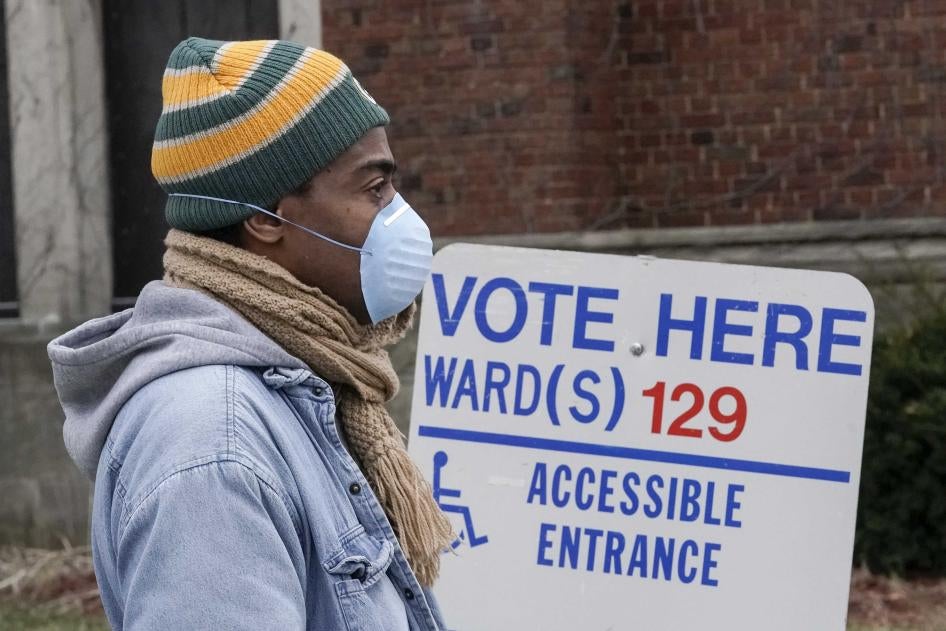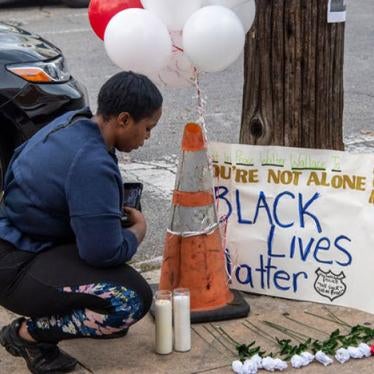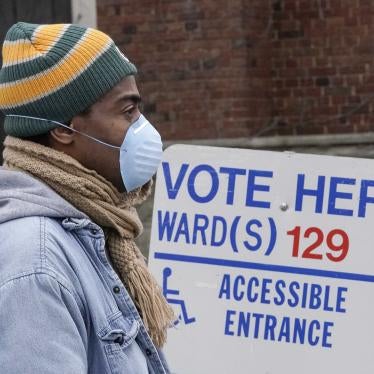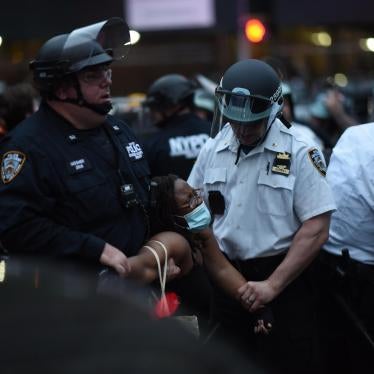The potential for intimidation and violence by extremist individuals or groups during and after the United States general election on November 3, 2020 has been raised by the Federal Bureau of Investigation (FBI), national security experts, civil and human rights organizations, and groups that monitor conflict and extremism. In October, the Department of Homeland Security (DHS) warned that violent extremists, particularly white supremacists and anti-government movements, “remain the most persistent and lethal threat” to national security and “might target events related to the 2020 Presidential campaigns, the election itself, election results, or the post-election period.”
Many experts believe that any incidents, if they occur, will be isolated. Still, the potential for intimidation or violence – and the authorities’ response – poses challenges for human rights.
This questions-and-answers document addresses these challenges and the international legal obligations of federal, state, and local authorities to keep the public safe while safeguarding the rights to vote, freedom of expression, and peaceful assembly. It highlights the authorities’ obligations to prevent voter intimidation, including in states where laws allow people to carry guns in and around polling places.
How are extremist beliefs or ideologies linked to violence?
What are some examples of extremist violence in the United States?
How serious is the threat of election-related violence?
How should authorities respond to intimidation or threats toward voters?
Are private individuals allowed to carry guns at polling places in the US?
Are private individuals or groups allowed to carry weapons at demonstrations?
How should authorities in the US respond to violence at the polls?
How should the authorities respond to violence at demonstrations?
What is meant by extremism?
Extremism refers to political, ideological, or religious beliefs that lie substantially outside broadly accepted belief systems. Under international human rights law, extremist views are not unlawful and are protected by the right to freedom of thought, even when they may be highly offensive to others. Many individuals who hold or promote extremist views do not espouse violent means to achieve their aims, including in cases in which their goals overlap with those of violent individuals or groups. This document uses the term violent extremism to refer to actions by individuals or groups that go beyond protected speech, such as threatening, inciting, attempting, planning, or committing serious violence in the name of political, ideological, or religious beliefs.
There is no universally accepted definition of violent extremism or terrorism, and the two terms are often used interchangeably, though terrorism is usually understood to refer to actions that have the goal of creating widespread fear and influencing a political outcome. The United Nations independent expert on human rights and countering terrorism has warned that both terms are “overly vague” and prone to “abusive application” by governments to target individuals or groups whose actions are not violent or unlawful, or to countenance violent and unlawful acts by groups whose views they share. Some national security analysts consider violent extremism to include acts such as vandalism and spontaneous violence in addition to premeditated violence. Hate crimes directed at individuals based on characteristics such as race, religion, disability, sexual orientation, ethnicity, gender, or gender identity, may rise to the level of violent extremist or terrorist acts, but may also include serious yet nonviolent crimes such as racial or sexual harassment.
How are extremist beliefs or ideologies linked to violence?
Extremist groups, movements, and individuals may espouse any number of political, religious, or ideological beliefs. Many US-based extremist movements are amorphous, and not all extremist movements or individuals espouse violence. In the United States, national security analysts and civil society organizations often use terms such as “extreme right” or “far right” to refer to white supremacists such as neo-Nazis, members of self-styled militias and armed conspiracy theorists who oppose government authority and gun control, male supremacists such as “involuntary celibates,” and ideologies that are virulently anti-choice or anti-LGBT (lesbian, gay, bisexual and transgender). While some extremist armed groups label themselves “militias,” private individuals in the US have no independent legal authority to organize and deploy as a lawful armed group.
National security analysts and groups that monitor extremism often use “extreme left” or “far left” to describe anarchists or anti-capitalist and anti-globalization activists and self-styled anti-fascist and anti-racist militias. The FBI classifies animal-rights activists and environmental defenders as violent extremists if they espouse violence.
Violent religious extremism in the United States is not limited to any particular faith and may overlap with other forms of extremism such as racism.
While the US government has often referred to right-wing extremist violence as “domestic terrorism,” a number of US-based extreme-right movements or individuals maintain links to transnational armed extremist movements or are inspired or courted by them. Examples include the Russian Imperial Movement (RIM), the only white supremacist group on the US Department of State’s global terrorist list, and the neo-Nazi Atomwaffen Division. Some of these groups adopt the social media tactics of pan-national Islamist extremist groups such as al-Qaeda and the Islamic State (also known as ISIS). Some US sheriffs, police, and other law enforcement officers, as well as current or former members of the armed forces, are members or followers of US-based extremist armed groups, most often on the far right.
What are some examples of extremist violence in the United States?
Since the September 11, 2001 attacks, which killed 2,977 people, much of the attention of the US government and public has focused on Islamist extremist threats from or inspired by al-Qaeda and allied armed groups and, in recent years, on ISIS. However, the majority of extremist plots and attacks in the US since 1994 have been linked to US-based extreme-right individuals and groups, according to a 2020 report by the Center for Strategic and International Studies.
The increase has been particularly dramatic since 2016, with 90 percent of all violent extremist plots and attacks in the United States during the first five months of 2020 attributed to the extreme right, the Center for Strategic and International Studies said. In September, FBI Director Christopher Wray testified before Congress that the most “lethal” US-based violent extremists since 2001 were racially or ethnically motivated and that in 2019 the FBI “elevated racially motivated violent extremism” to one of its top two national threat priorities.
In 2020, he said, the lethal attacks “all fit in the category of anti-government, anti-authority, which covers everything from anarchist violent extremists to militia types.” Wray did not break down the numbers of anti-government and anti-authority attacks in 2020 by particular movement or group, but other studies say the extreme right carried out the vast majority.
The deadliest act of extremist violence in the United States prior to the September 11 attacks was the 1995 bombing of a federal government building in Oklahoma City, Oklahoma by an anti-government military veteran, Timothy McVeigh. The bombing killed 168 people, including 19 children, and injured 684 others.
High-profile attacks in the United States attributed to violent right-wing extremists in recent years include the 2015 mass shooting by an avowed white supremacist that killed nine Black worshipers at a Baptist church in Charleston, South Carolina; a 2015 mass shooting by an avowed “warrior for babies” that killed three people at a Colorado Planned Parenthood; the 2017 death of a counter-protester by an avowed white supremacist who rammed his car into a crowd at a “Unite the Right” extreme-right rally in Charlottesville, Virginia; the 2019 mass shooting, allegedly by a man who issued an anti-Latino manifesto that killed 23 people at a Walmart in El Paso, Texas; and the 2018 mass shooting that killed 11 worshipers at a synagogue in Pittsburgh, Pennsylvania. In 2019, a Florida man pleaded guilty to mailing inoperative letter bombs to 13 targets including 11 prominent Democratic Party members in the weeks preceding the 2018 congressional elections.
Attacks in recent years in the United States motivated by Islamist extremist ideologies include the 2013 bombings by two brothers that killed three people and injured hundreds at the Boston Marathon; the 2015 mass shooting by a couple that killed 14 people at a Health Department Christmas party in San Bernardino, California, after the husband pledged the pair’s allegiance to ISIS on Facebook; the 2016 mass shooting, by a man who pledged allegiance to ISIS and claimed he was avenging US attacks in Syria and Iraq, that killed 49 people at a gay nightclub in Orlando, Florida; the 2017 truck-ramming attack by an Uzbekistan-born, permanent US resident allegedly acting in the name of ISIS that killed eight people on a New York City bike path; and the 2019 gun attack by a Saudi Air Force cadet who was training with the US military that killed three US sailors at a naval air base in Pensacola, Florida.
What are examples of extremist threats and violence that have drawn a law enforcement response in the months preceding the November 3 elections?
Attacks and planned attacks during, but not necessarily related to, the 2020 election campaign have targeted the presidential candidate Joseph Biden and Governor Gretchen Whitmer of Michigan, and protesters against racial injustice and police brutality. In October, the FBI and state authorities charged 14 men in an extreme-right plot to kidnap Whitmer, a Democrat, largely because they opposed her measures aimed at protecting the public against the Covid-19 pandemic, and to seize the state’s capitol. The plotters also discussed “taking” the governor of Virginia for the same reason, the FBI said. Federal and state authorities said the suspects included members of Wolverine Watchmen, an anti-government armed group, and adherents of the Boogaloo, an amorphous anti-government movement whose armed followers often wear Hawaiian shirts and say they are preparing for a US civil war.
The authorities have also charged Boogaloo followers – known as “bois” or “boys” – with violence at protests decrying the police killing of George Floyd in May, in one case with killing a federal security officer in Oakland, California, and in another with firing 13 shots into a police station with an assault rifle in Minneapolis, Minnesota. Extreme-right groups and individuals, including a man whom prosecutors describe as a self-declared Ku Klux Klan member, have been implicated in sometimes deadly vehicle rammings at racial injustice rallies.
A few incidents have been attributed to extreme-left individuals, movements, or groups. They include the fatal shooting in August, allegedly by a follower of the amorphous, anti-fascist movement Antifa, of a counter-protester with the extreme-right group Patriot Prayer at a protest against racial injustice and police brutality in Portland, Oregon. Without explicitly stating that he fired the shot, the alleged shooter said in a videotaped interview that he acted in self-defense. A video from the scene shows the victim firing pepper spray toward the alleged shooter moments before he was shot. Days later, members of a US Marshals Service task force killed the suspect in a controversial confrontation. Despite some assertions to the contrary from ranking US officials, very few protesters charged with crimes during rallies against racial injustice have been linked to leftist violent extremism, according to an Associated Press review of court documents.
Other cases defy easy categorization. A 19-year-old man arrested in May with a van full of guns and explosives had made detailed plans to kill Biden but also had a note on his phone proposing a mass shooting at a mall food court on Christmas or a Black Friday, the shopping day following Thanksgiving. He was charged for possessing thousands of child pornography images, according to court papers filed in October.
A 17-year-old boy was charged with fatally shooting two unarmed Black Lives Matter protesters with an AR-15 style semi-automatic rifle in August when they tried to disarm him during a rally in Kenosha, Wisconsin. The suspect reportedly espoused the Blue Lives Matter counter-movement and was praised by conservative commentators as a “patriot,” but has not been linked to an extreme-right ideology.
How serious is the threat of election-related violence?
Experts have expressed differing views on the potential for violence before, during, or after the November 3 elections. While urging caution, Brian Michael Jenkins, a security analyst with the Rand Corporation, estimated that violent extremists probably represent only a “tiny fraction” of the US population and called much of the increased social media content from self-styled election vigilantes “chest-thumping and fantasy threats.”
Reports have nonetheless surfaced of possible voter intimidation during early balloting and plans for armed groups to show up at polling locations on election day. In addition, many extreme-right members or sympathizers celebrated President Donald Trump’s comment during the first presidential debate in September that the white supremacist group Proud Boys should “stand back and stand by.” Groups such as the extreme-right, anti-government Oath Keepers, whose members include current and former military and law enforcement members, have said they would take up the president’s appeal for supporters to “go into the polls and watch very carefully” and some have signed on as poll watchers.
How should authorities respond to intimidation or threats toward voters?
International human rights law prohibits voter intimidation and requires the authorities to protect the right to vote from interference through threats, harassment, or violence. The human rights to freedom of expression, including of offensive political views, and peaceful assembly need to be protected. But international human rights law also recognizes that these rights can be restricted if necessary and proportionate to protect the rights of others, including the right to vote. This is particularly relevant in the immediate vicinity of and inside polling places, where the authorities should ensure an environment free from voter intimidation.
Voter intimidation is also illegal under US federal and state law. In the US, the Supreme Court has ruled that speech that creates a “clear and present danger” to others is not protected, as well as certain “fighting” – inciteful – words. Federal law says that “no person ... shall intimidate, threaten, coerce ... any other person for the purpose of interfering with the right of [that] person to vote or to vote as he may choose.” Many US states have their own laws prohibiting voter intimidation.
Are private individuals allowed to carry guns at polling places in the US?
In many US states, licensed individuals may carry guns, concealed or in the open, at polling places but not to intimidate or commit violence. Four states – Mississippi, Missouri, Nebraska, and South Carolina – prohibit concealed firearms at the polls but allow open carrying. Six states – Arizona, California, Florida, Georgia, Louisiana, and Texas – and the District of Columbia explicitly prohibit guns at voting sites. Guns may also be prohibited when balloting takes place in schools and other types of public property where many states do not permit firearms. In October, Michigan announced an election-day ban on concealed firearms within 100 feet of polling places, which is being challenged in court.
Six other states – Illinois, New York, South Carolina, Massachusetts, Minnesota, and New Jersey – prohibit people from openly carrying handguns, long guns, or both anywhere in public. Even where guns are not prohibited outright, nearly all 50 states have laws that prohibit using firearms to intimidate others.
In accordance with international human rights law, which prohibits voter intimidation, the authorities need to ensure that private individuals carrying guns do not intimidate other voters, even if state law permits them to carry a gun to polling places. The failure to ensure that polling places are not intimidating is likely to violate the right to vote and may constitute racial, sexual, or other discrimination under human rights law.
Are private individuals or groups allowed to carry weapons at demonstrations?
In many states in the US, individuals may carry guns or other weapons at demonstrations provided that they do not intimidate others, or incite or commit violence. Protesters have openly carried weapons at demonstrations about Covid-19 restrictions and counter-protesters have carried them at racial injustice demonstrations, raising concerns of intimidation even when the weapons were not used.
Federal law does not restrict the open carrying of firearms in public, and according to Giffords Law Center only eight states – California, Florida, Illinois, New York, South Carolina, Massachusetts, Minnesota, and New Jersey – and the District of Columbia generally prohibit people from openly carrying handguns, long guns, or both in public. Four states – Alabama, Illinois, Maryland, and North Carolina – and the District of Columbia prohibit both concealed and open carrying of firearms at demonstrations or licensed public gatherings. Mississippi, Arkansas (for participants in permitted demonstrations), and Louisiana (for permitted demonstrations or parades) permit open carrying, but prohibit concealed carrying of firearms.
The US Constitution, state constitutions, and the International Covenant on Civil and Political Rights (ICCPR), which the United States ratified in 1992, provide for the right to peaceful assembly. According to the United Nations Human Rights Committee, the body that monitors implementation of the ICCPR, the authorities “must promote an enabling environment for the exercise of the right to peaceful assembly without discrimination, and put in place a legal and institutional framework within which the right can be exercised effectively.”
Law enforcement officials have an obligation under international law to protect participants in demonstrations from abuse, including violent conduct directed at them by counter-protesters or other individuals. Violent conduct includes not only the commission of violence but also credible evidence that groups or individuals are inciting or planning violence, or that they will imminently become violent.
When an individual or group carries firearms or other weapons at demonstrations, that alone does not constitute violence. The Human Rights Committee said that whether carrying a weapon at a demonstration constitutes violence “has to be determined on a case-by-case basis, dependent on, among other considerations, domestic regulation on the carrying of weapons (especially firearms), local cultural practices, whether there is evidence of violent intent, and the risk of violence presented by the presence of such objects.”
How should authorities in the US respond to violence at the polls?
Officials at all levels should publicly condemn and take measures to prevent intimidation and violence against voters who are traveling to, at, and leaving polling places.
Depending on the governing state or local law, law enforcement may be present at polling places but subject to numerous restrictions. Such officers should be focused on providing public safety and protecting the right to vote. Their role should be neutral, impartial, and disengaged from the political process to comport with international human rights standards. Under no circumstances may state or local police intimidate voters, prevent people from voting, or target particular racial, religious, ethnic, or other groups. State and local law enforcement should recognize that even their presence can intimidate citizens from exercising their fundamental right to vote. Under US law, deploying the military or federal law enforcement to polling places is illegal.
When responding to violence at a polling place or demonstration, law enforcement should act in accordance with the UN Basic Principles on the Use of Force and Firearms by Law Enforcement Officials, ensure proper use of less-lethal weapons, and use the minimum force needed to stop the violence.
Law enforcement authorities should thoroughly investigate and appropriately prosecute violence against voters, election officials, candidates, elected officials, protesters, and others.
How should the authorities respond to violence at demonstrations?
The authorities should meet their obligations under international law to protect the right of peaceful assembly at election-related demonstrations by adopting measures to enable such assemblies and to protect demonstrators from violence directed at them by counter-protesters or others. In a letter to over 3,500 mayors and city council members on October 20, Human Rights Watch and three other leading human rights organizations said law enforcement officers should presume that all assemblies are nonviolent, even in cases in which there may be isolated incidents of violence, or in which small groups of external actors – such as counter-protesters – may engage in violence. Local authorities should restrict such assemblies only when the restrictions are necessary, proportionate, and the least intrusive measures necessary to achieve a legitimate goal, such as protecting the rights of others or maintaining public order.
Violence against participants in a peaceful demonstration does not make the assembly itself non-peaceful. The authorities should not disperse peaceful assemblies, even if they deem them unlawful, unless there is “clear evidence of an imminent threat of serious violence that cannot be reasonably addressed by more proportionate measures.”
Law enforcement should minimize arrests. Even in the event of violence, they should only use force as a last resort, if necessary and proportionate to address a genuine threat, and if other measures to address that threat have proved ineffective or have no likelihood of achieving the intended result. Any use of force should be preceded by clear warnings.
Federal and state authorities should investigate and address credible allegations or evidence of collusion by police and other local law enforcement officials, or members of the armed forces in election- or protest-related intimidation and violence. They should place any officials who are under investigation on leave pending appropriate disciplinary measures or prosecution.
What should social media companies do about online content that incites violence or promotes election misinformation?
Social media platforms and other internet companies have a record of responding to violent extremist content on their platforms with overbroad and vague policies and practices. These companies have a responsibility under the UN Guiding Principles on Business and Human Rights to respect human rights and mitigate harm – such as incitement to violence or harassment – resulting from their business practices. Facebook and Twitter have expanded rules aimed at blocking violent extremist content and election misinformation, which have flourished on social media, but their efforts have been only partially successful. Facebook has said it may slow the spread of viral content and tweak news feeds in the event of severe election-related violence.
When internet companies take action such as deletion or moderation to restrict third-party content that goes beyond legal requirements – for example to preserve the integrity of the electoral process – they should adopt clear, pre-determined policies to govern those actions that protect freedom of expression and privacy. Those policies should be based on objectively justifiable criteria that can be easily accessed and understood, with clear information about how they are enforced. Platforms should prioritize transparency and apply their policies in a fair, unbiased, and consistent manner. They should provide users with a fair process and access to remedies.








